In this article we’re going to be discussing different ways to improve the efficiency of your existing chiller setup. We’re going to cover Compressor Retrofit, Compressor VFD, Chilled Water Reset, Condenser water reset, Condenser and Evaporator cleaning, Expansion Valve, Air cooled chiller, condenser fans, Free cooling or Economiser cooling, Chiller and plant sequencing, Controllers and fittings, Cooling tower, Pumps and AHU fan VFD’s
Scroll to the bottom to watch the video tutorial on this article
Need to improve the efficiency of your exisit chiller? See the wide range of Danfoss chiller solutions at Chillers.Danfoss.com
Danfoss has a wide portfolio of products to you boost efficiency in whatever chiller system you’re working with. Their products include compressors, AC drives, system protectors, heat exchangers, valves, electronics, and sensors. They’re committed to helping you build better chillers — from the inside out. Learn more at Chiller.Danfoss.com
In most applications, chillers are the single largest energy consuming piece of equipment within a building. There’s a lot of pressure on engineers as well as building and facilities managers to reduce the energy consumption and carbon footprint of buildings so chillers are naturally going to be in the focal point for this. We’ll have a look at both low-cost options as well as some potential projects to help achieve this.
How Chillers use energy
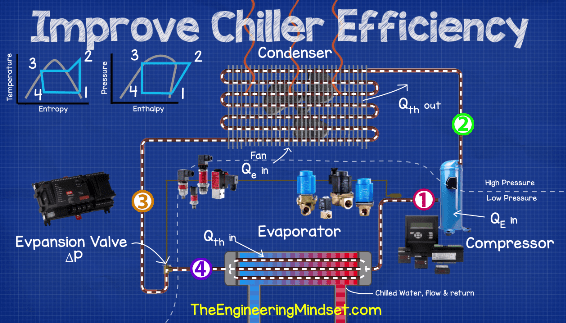
Let’s first consider how energy is used in chillers. First we have the compressor, this takes low pressure refrigerant and compresses it to a higher pressure, for this to work we input electrical energy represented by Qein.
As the refrigerant moves it takes away the buildings unwanted thermal energy from the evaporator so we have thermal energy entering the system here represented by Qthin.
This is then rejected from the condenser so we have energy leaving the system here represented by Qthout. We also have fans on air cooled chillers which run to force the unwanted heat to dissipate, so we have electrical energy entering here also represented by the Qein.
The condenser and evaporator are heat exchangers and they are exposed to water, dirt and biological growth which cause restrictions to the heat transfer. This results in reduced performance and increased energy consumption to achieve the design criteria.
Between the evaporator and condenser, we have the expansion valve which maintains the pressure differential between the high and low pressure side, this also controls the flow of refrigerant into the evaporator and ultimately the compressor.
Then we have the controls and fittings that dictates how the system works.
So we have lots of components which are all playing their part in the system to change and control the movement of thermal energy and pressure at different points. All of these play a part in how much energy the chiller will consumer.
Let’s work our way around the system to consider different ways to reduce the energy consumption for chillers. I do just want to point out that the estimated energy savings listed for each of the items is for the individual implementation, you can combine the steps mentioned but the potential savings will not simply add together, they will diminish.
The first area we’ll consider is the most energy intensive part, that being the compressor. In our previous video we looked at chiller types and applications where we covered the different types of compressors, the applications and efficiency. Check that out as it will help with your understanding, additionally I highly recommend checking out of Essential Chiller Terminology article and video tutorial which will help you become fluent in chiller language.
Compressor retrofit:
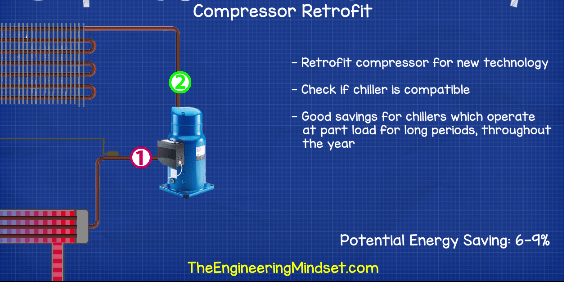
In many cases the compressor of a chiller is able to be retrofitted with a newer technology. Check with the chiller manufacturer or your chiller service specialist if your chiller can be retrofitted. If so, the payback can be very quick. For example, replacing a fixed speed scroll compressor for a variable speed compressor can lead to a ~9% reduction in energy consumption. The biggest factor affecting the savings is how much of the year does the chiller operate at part load. If it’s at full load for most of the year then there will be little to no saving however if the chiller operates at part load for the majority of the year, which the majority of chillers do, then there is a big potential here for energy savings.
Compressor VFD retrofit:
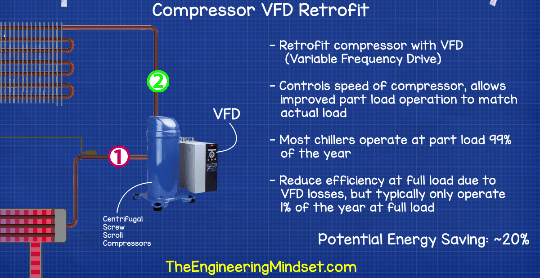
If it’s not feasible to replace the compressor, VFD’s or variable frequency drives can often be fitted to the compressor, allowing the chiller to perform more efficiently at part load conditions. The efficiency at full load however will be reduced because of the losses from the inverter. Most chillers will operate at part load conditions for the majority of the year so this is an attractive option. Retrofitting a VFD can often lead to energy savings of around 20% Important: Not all compressors can be retro fitted with a VFD, for example scroll compressors should be replaced with VFD compressors instead of trying to retrofit. Check with a local specialist for compatibility.
The next part is to consider what the chillers compressor does and how its linked to the operating conditions of the evaporator and condenser. Remember it takes a low pressure refrigerant and compresses it to a high pressure. This is what the electricity is used for. So lets look at some ways to reduce this.
Chilled water reset:
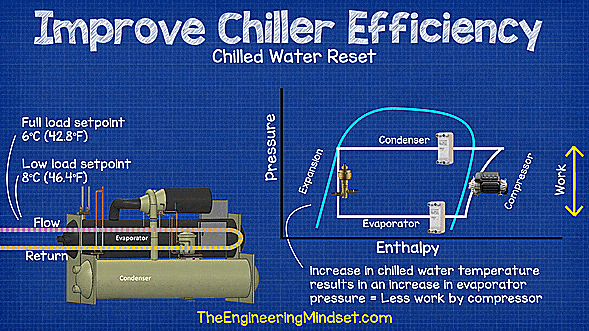
The chilled water outlet temperature was traditionally fixed, usually somewhere around 6°C or 42.8°F but it’s common practice now to apply a chilled water reset strategy. The chilled water reset allows the temperature of the chilled water to be increased during part load conditions. This reduces the amount of work done by the chillers compressor.
The increase in chilled water temperature results in an increase in evaporator pressure of the refrigerant. The compressor takes the refrigerant at the evaporator pressure then compresses it and increases its pressure to the condensers pressure, so the higher the evaporator pressure the less work the compressor needs to do to increase that pressure.
As a rule of thumb, the chiller efficiency can be increased by 1-2% per degree C the chilled water temperature is increased.
There are lots of ways to implement this, you should first check with your chiller manufacturer if this is applicable to your chiller and ask what temperature or pressure limits should be imposed. If it is applicable then you can start to decide what will be the deciding factor for temperature change because there are many ways to do this.
We won’t go into too much detail on that in this article but some common options are to control based on outside air temperature, to control based on the actual load, both sensible and latent heat or to control based on the average or highest demanding vale position on the cooling coils.
Before implementing chilled water reset, its important to consider
- The chilled water pumps will increase in speed for variable volume systems, to meet the cooling load. The optimal point should be calculated to make sure the increase in pumping power doesn’t offset the savings from the chiller.
- The cooling coils are often used for humidity control. The temperature of the chilled water is crucial for this so check if this is applicable to your system.
- Check if the chiller manufacturer recommends any temperature and pressure limits for the water or refrigerant.
Condenser water reset:
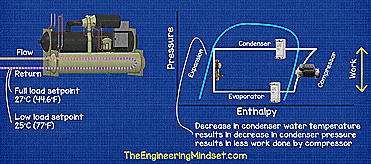
This can only be implemented on water cooled chillers as air cooled do not use condenser water. This is very similar to the chilled water reset we just looked at, by reducing the temperature of the condenser water you will reduce the amount of work the compressor needs to do because the decrease in water temperature will result in a reduction in condenser refrigerant pressure.
Again, as a rule of thumb you can save 1-2% per degree C reduction. Usually the condenser water return temperature setpoint is fixed at around 27°C or 80°F and the cooling tower fans or bypass line adjust to control this temperature.
Some regions of the world with temperate climates will be able to reduce the condenser water temperature as the outdoor wet bulb temperature decreases. This will reduce the condensing pressure of the refrigerant so the compressor has to do less work. There are limits on how low you can go though, eventually the chiller will shut off to protect itself so check with the manufacturer first before doing so.
Cleaning the chiller
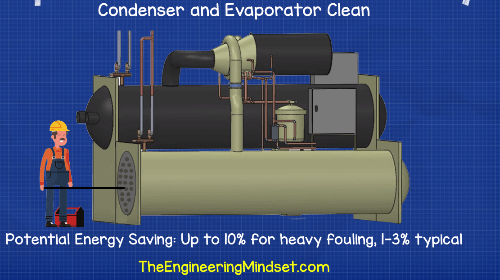
This should be a fairly obvious one but you’ll find buildings that have either never cleaned their chillers heat exchangers or they do it infrequently.
Every chiller is designed to have some amount of fouling but over time biological growth, dust, foreign particles and internal particles from corrosion will build up and line the surfaces of the pipes and heat exchangers causing the pumps to work harder but also reducing the ability of the heat exchanger to transfer thermal energy between the water and refrigerant.
Appropriate water treatment should be carried out to maintain the system, you should contact a local water treatment specialist to determine the correct chemicals and dosing intervals. Additionally, the condenser and evaporator should be physically cleaned periodically.
For condensers connected to open cooling towers then its good practice to clean these annually.
For evaporators and condensers on closed loops then its good practice to physically clean every 3 years.
The amount you can save really depends on how much fouling has built up on the surfaces. Cleaning heavily fouled chiller could lead to an energy saving of up to 10% where as a lightly fouled chiller would see 1-3% improvement. This is going to depend on how much fouling builds up as well as how long the chillers run. Its best to keep a daily log of operating conditions to compare the performance overtime, this will indicate when its economical to isolate the chiller and clean it.
Don’t forget to also clean the fins on the condenser of an air-cooled chiller. Over time these can accumulate dirt, dust, pieces of trash, animal nests and biological material which builds up on the surfaces and reduces the heat transfer effectiveness.
Expansion valve:
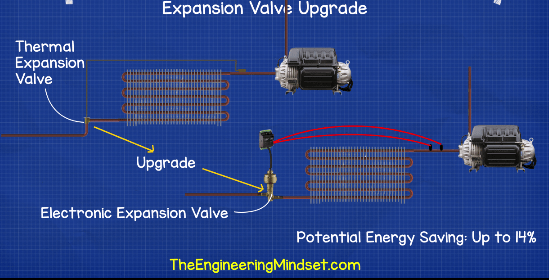
Many chillers use a thermal expansion valve to control the flow of refrigerant into the evaporator to achieve the desired superheat.
If you want to know how TXV’s work we’ve previously made a very detailed animation video, click here to see.
The thermal expansion valve can be replaced with an electronic expansion valve which will provide much more stable superheat especially at low loads and because its digital it’s able to respond to changes and control the super heat with greater speed and precision.
It does this by measuring both the pressure and temperature at the outlet of the evaporator. The precision allows the condensing pressure to be reduced so the compressor therefore doesn’t need to work so hard. By replacing a thermal expansion valve with an electronic expansion valve, energy savings of around 14% are possible but this varies on the loading of the chiller.
Air cooled chiller, condenser fans
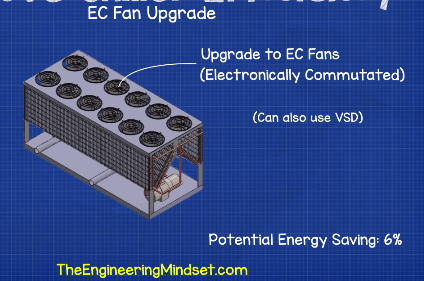
Air cooled chillers will use condenser fans to reject the heat. These are often controlled to run either 100% off or 100% on with no variations between. Sometimes these fans are grouped together to provide cooling stages especially on larger units. These fans can be replaced with EC or electronically commutated fans which allow the fans to vary speed and airflow. This provides a much more uniform airflow over the condenser coils and also allows energy savings. Replacing the fans of an air cooled chiller with EC fans can lead to around 6% energy reduction.
Free cooling or Economiser cooling

This is a very popular choice for data centers but it can and is also used for commercial buildings. It involves removing the unwanted heat from the cooling system without the use or with minimal use of the compressors. This isn’t possible in all locations it can only be used when the out door air temperature is below the chilled water set point temperature.
Using a free cooling or economiser strategy allows the chillers compressor to be turned off, however the pumps and fans will still run and will likely run at high speeds so some of the savings from the compressor being off are offset here. Using a free cooling cycle could reduce the chillers annual energy consumption by 20-50% again this really depends on the local ambient conditions and setpoint temperature.
Air cooled chillers sometimes have a free cooling feature built in which uses the fans without the compressors if conditions are right, but I’ve came across some installations where this hadn’t been commissioned so check with the manufacturer if this feature is available or if it can be retro fitted.
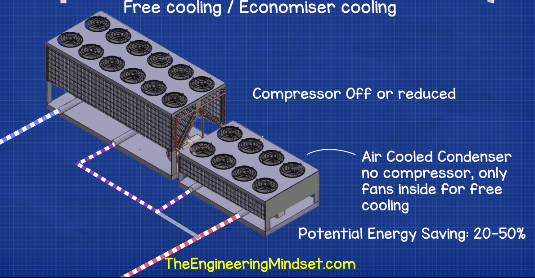
Alternatively air cooled condensers can be fitted into the system to use just ambient air to remove as much heat as possible before reaching the chiller.
For water cooled chillers a common approach is to connect the condenser circuit and the chilled water circuit via a plate heat exchanger to directly transfer heat.
Controls, Controllers and fittings
Where possible choose digital controllers and sensors as these can perform faster and with more precision. When replacing a fitting check with manufacturers whether there are more energy efficient and reliable fittings available. With both fittings and controls equipment, over time manufacturers will stop manufacturing parts which means it becomes harder and more expensive to obtain spare parts from third parties. Do stay on top of this and do not just replace like for like, always seek improvement.
On the controls side, the manufacturer will quite often release new software updates periodically for the controllers and equipment, make sure the service and BMS engineer or servicing company is updating your systems, where possible, as this will allow the controllers to operate more effectively and without bugs. If you use a third party to service your chillers, pressure them to come up with new energy saving controls strategy not just for the chiller but also how it interacts with the entire cooling system. You can ask for this as part of their normal service or for a contract renewal or just ask them to provide quotations for improvements.
Chiller & plant sequencing
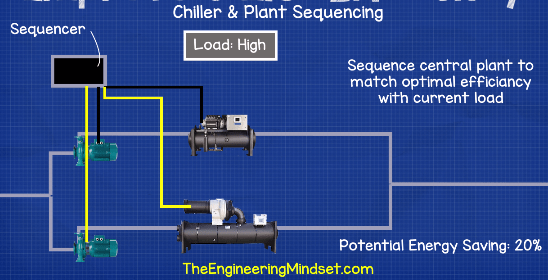
The chiller, cooling towers and pumps all have different efficiency curves especially at part load conditions. A plant sequencer can be used to ensure that the most efficient combination of plant items is used to match the current cooling load. The sequencer can be either just for the chillers or more advanced ones will include all the associated large plant items.
If you opt for the combined plant sequencer then it’s possible to reduce the entire systems energy consumption by around 20% sometimes higher but this depends on how bad the controls strategy previously was and how efficient your plant items run at part load.
Cooling tower, AHU and pump VFD
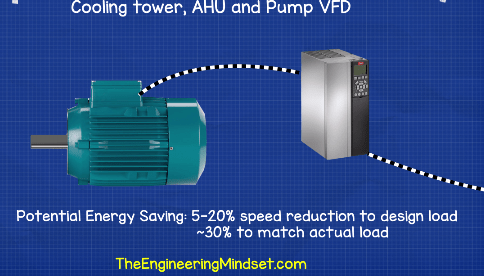
The cooling tower fans, chilled and condenser water pumps and AHU’s all use induction motors. Although these are not part of the chiller they are part of the cooling system which the chiller is serving and how they work will affect the performance of the chiller. These motors can easily be integrated with variable speed drives to produce large energy savings. You’ll often find that the pumps and fans are providing a higher flow rate than the system was designed for, you can check the buildings commissioning data for this. These plant items are typically oversized by 5-20% so fitting VFD’s allows these to be ramped back to closely match the design.
Additionally with some sensors and controls the VFD’s can be used to suit the actual load and vary the speed to accurately match this. Using this method can typically lead to a 30% reduction in energy consumption per motor.

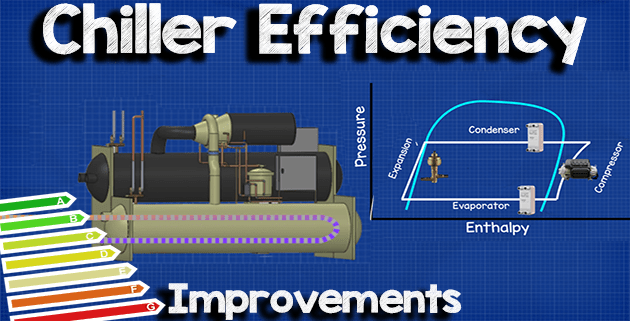
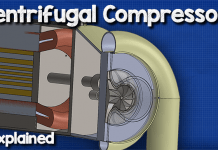
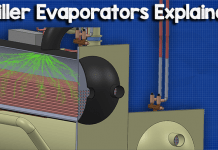
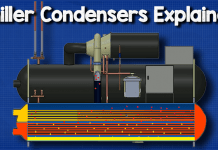
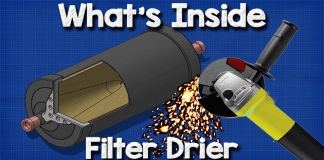

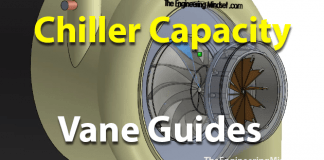
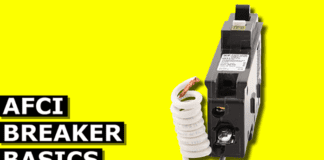
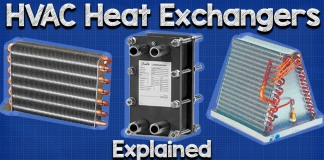
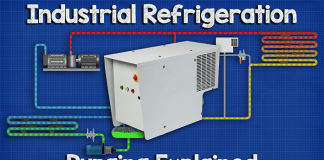








[…] our previous chiller article, we discussed different ways to improve the efficiency of an existing chiller, you can learn about […]
Excellent, you have mentioned everything paul. bookmarked the page.
Thanks for this post
The biggest area of energy-saving is head pressure control.
I would dispute 6% energy savings from EC fan upgrade.
15-25% is possible if you are able to reduce head pressure.
Good info. Will come back to this site again.
Hello,
I would like to ask if somebody can help me to define set point for coiling system to control chiller. Thank you.
Why compressor oil comes in the evaporator, even if an oil separator is installed. Evaporator tube leakage oil, water, and refrigerant mix in my case. I will be very grateful if you make this video by giving the real reason.